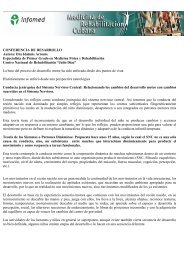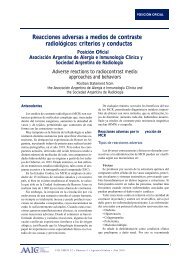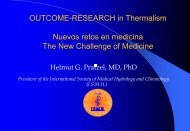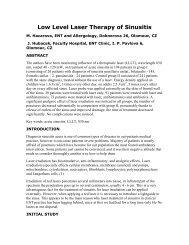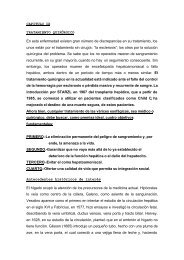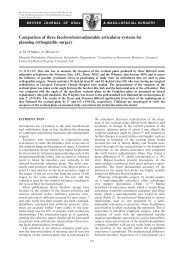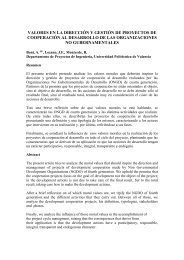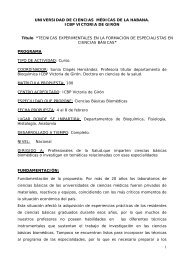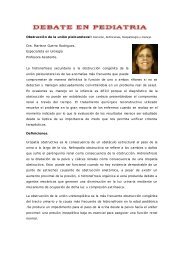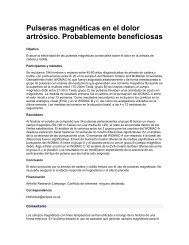pharmacology of medicinal plants and natural products
pharmacology of medicinal plants and natural products
pharmacology of medicinal plants and natural products
Create successful ePaper yourself
Turn your PDF publications into a flip-book with our unique Google optimized e-Paper software.
MEDICINAL PLANTS (NATURAL PRDUCTS)<br />
S99<br />
acuminata <strong>and</strong> Indoplanorbis exustus. The cidal effect<br />
<strong>of</strong> pure azadirachtin was greater then that <strong>of</strong> the<br />
synthetic molluscicides 192 .<br />
15. Anti-mutagenic <strong>plants</strong><br />
Punark, a mixture <strong>of</strong> solvent extracts <strong>of</strong> <strong>natural</strong> <strong>products</strong>,<br />
namely turmeric (Curcuma longa), betel leaf<br />
(Piper betel) <strong>and</strong> catechu (Acacia catechu) protected<br />
against benzo (a) pyrene induced chromosomal damage<br />
in human lymphocytes in vitro 193 . Alcoholic extracts<br />
<strong>of</strong> tumeric oil (TD) <strong>and</strong> tumeric oleoresin (TOR)<br />
showed anti-mutagenic effect in vitro. They also demonstrated<br />
chemoprotective effect in lymphocytes <strong>of</strong><br />
normal healthy subjects in vitro when tested against<br />
benzo (a) pyrene induced DNA damage. In vivo the<br />
extracts reduced DNA damage (cytogenetic damage)<br />
in oral mucosal cells <strong>of</strong> patients with oral submucous<br />
fibrosis 194 .<br />
Water, oil <strong>and</strong> alcoholic extracts <strong>of</strong> nuts <strong>of</strong><br />
Semecarpus anacardium were found to be anti-mutagenic<br />
when tested against benzo (a) pyrene (BZP)<br />
in the bacterial test system using Salmonella<br />
typhimurium strains TA98 <strong>and</strong> TA100. The water extract<br />
was less effective as compared to the oil <strong>and</strong><br />
alcoholic extracts. In addition, the water <strong>and</strong> alcoholic<br />
extracts showed anti-mutaginic effect when<br />
tested in lymphocyte cultures <strong>of</strong> normal healthy volunteers<br />
195 .<br />
Ellagic acid, a fraction isolated from Terminalia arjuna<br />
has been evaluated for it anti-mutagenic potential in<br />
TA98 <strong>and</strong> TA100 strains <strong>of</strong> Salmonella typhimurium<br />
against direct <strong>and</strong> indirect - acting mutagens. The<br />
fraction was quite effective against S9-dependent<br />
2AF while it showed moderate effect against NPD 196 .<br />
16. Anti-cancer <strong>plants</strong><br />
The potential role <strong>of</strong> various <strong>plants</strong> in cancer therapy<br />
as either a direct anti-cancer agent, chemopreventive<br />
agent, radiosensitizer or immunity enhancer is presented<br />
in the following paragraphs.<br />
Evaluation <strong>of</strong> the in vitro anti-cancer effects <strong>of</strong><br />
bi<strong>of</strong>lavonoids, viz. quercelon, catechin, luteolin <strong>and</strong><br />
rutin against human carcinoma <strong>of</strong> larynx (Hep-2) <strong>and</strong><br />
sarcoma 180 (S-180) cell lines showed that only<br />
luteolin <strong>and</strong> quercetin inhibited the proliferation <strong>of</strong> the<br />
cells. Luteolin caused depletion <strong>of</strong> glutathione in the<br />
cells <strong>and</strong> a decline in DNA synthesis, as seen by 3 H<br />
thymidine uptake studies, thus demonstrating its anticancer<br />
potential 197 .<br />
The anti-tumor effect <strong>of</strong> the crude extract <strong>of</strong> Centella<br />
asiatica as well as its partially purified fraction was<br />
studied in both, in vitro short <strong>and</strong> long term<br />
chemosensitivity test systems <strong>and</strong> in vivo tumor<br />
models. The purified fraction inhibited the proliferation<br />
<strong>of</strong> transformed cell lines <strong>of</strong> Ehrlich ascites tumor<br />
cells <strong>and</strong> Dalton’s lymphoma ascites tumor cells more<br />
significantly than the crude extract. It also significantly<br />
suppressed the multiplication <strong>of</strong> mouse lung fibroblast<br />
cells in long term culture. In vivo administration <strong>of</strong><br />
both extracts retarded the development <strong>of</strong> solid <strong>and</strong><br />
ascites tumors <strong>and</strong> increased the lifespan <strong>of</strong> the<br />
tumor bearing mice. Tritiated thymidine, uridine <strong>and</strong><br />
leucine incorporation assays suggest that the purified<br />
fraction acts directly on DNA synthesis 198 .<br />
The methanol eluted fraction <strong>of</strong> the petroleum ether<br />
extract <strong>of</strong> the root bark <strong>of</strong> Salacia oblonga Wall<br />
showed 100% cytotoxicity on Ehrlich ascites tumor<br />
cells 86 .<br />
Fresh root suspension <strong>of</strong> Janakia arayalpathra exhibited<br />
strong anti-tumor effects in mice challenged<br />
with Ehrlich Ascitic Carcinoma (EAC) cells. It prolonged<br />
the survival <strong>of</strong> all mice <strong>and</strong> protected a number<br />
<strong>of</strong> mice from tumor growth, probably by enhancing<br />
the activity <strong>of</strong> the immune system 199 .<br />
Withaferin A, a steroidal lactone isolated from the<br />
roots <strong>of</strong> Withania somnifera, reduced survival <strong>of</strong> V79<br />
cells in a dose-dependent manner. The applicability<br />
<strong>of</strong> this drug as a radiosensitizer in cancer therapy<br />
needs to be explored 200 .<br />
Banerjee et al, 201 have studied the modulatory influence<br />
<strong>of</strong> the alcoholic extract <strong>of</strong> leaves <strong>of</strong> Ocimum<br />
sanctum on various enzyme levels in the liver, lung<br />
<strong>and</strong> stomach <strong>of</strong> mouse. Oral treatment with the extract<br />
significantly elevated the activities <strong>of</strong> cytochrome<br />
P450, cytochrome b5, arylhydrocarbon hydroxylase<br />
<strong>and</strong> glutathione S-transferase enzymes, all <strong>of</strong> which<br />
are important in the detoxification <strong>of</strong> carcinogens as<br />
well as mutagens. Moreover, it also significantly elevated<br />
extra-hepatic glutathione S-transferase <strong>and</strong><br />
reduced glutathione levels in the liver, lung <strong>and</strong> stomach.<br />
These observations suggest that the leaf extract<br />
or its active principles may have a potential role<br />
in the chemoprevention <strong>of</strong> chemical carcinogenesis.




